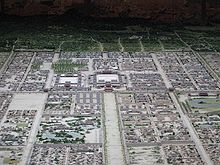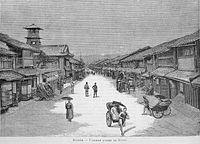Kyoto
![]()
Kyoto is a redirect to this article. For other meanings, see Kyoto (disambiguation).
Kyōto (![]() , in German usually Kyoto, more rarely also written Kioto; jap. 京都市 Kyōto-shi
, in German usually Kyoto, more rarely also written Kioto; jap. 京都市 Kyōto-shi![]() ) is one of the historically and culturally most important cities in Japan. It is located in the southwest of Japan's main island of Honshū in the Kansai metropolitan area. Both characters of the present-day city name are each read "Miyako" alone and literally mean "imperial residence" in Japanese. In today's Sino-Japanese reading, the syllable "Kyō-" corresponds to a Go-on reading and the syllable "-to" to a Kan-on reading.
) is one of the historically and culturally most important cities in Japan. It is located in the southwest of Japan's main island of Honshū in the Kansai metropolitan area. Both characters of the present-day city name are each read "Miyako" alone and literally mean "imperial residence" in Japanese. In today's Sino-Japanese reading, the syllable "Kyō-" corresponds to a Go-on reading and the syllable "-to" to a Kan-on reading.
Kyōto was the seat of the Imperial Court of Japan from 794 to 1868 and is now the administrative seat of Kyōto Prefecture.
14 temples and Shintō shrines, along with three others in the neighboring cities of Uji and Ōtsu, were designated UNESCO World Heritage Historic Kyōto (Kyōto, Uji and Ōtsu) in 1994.
Geography
Kyōto is located about 400 km southwest of Tokyo in the mid-west of Japan's main island of Honshū, about ten kilometers southwest of Lake Biwa and about 40 km from Osaka. Its location in a basin open only to the south causes the sultry air to accumulate in summer; the northern part of the city becomes considerably colder in winter than the neighboring cities of Osaka and Kōbe. Unlike the latter, however, Kyōto is largely protected from typhoons by mountains rising to over 1,000 metres and is also hardly at risk of flooding.
The city is laid out like a chessboard according to classical Chinese geomancy. The center and the south are the economic heart of the city. Some of the tourist attractions are located in the center; however, most of the famous temples are located in the northeast and northwest of the city or on mountain slopes in the surrounding area.

enlarge and show information about the picture
![]()
Panoramic view in west direction over the city center from Mount Daimonji-yama
City breakdown
Kyōto is divided into eleven municipal districts (-ku):
| the districts of the city of Kyōto | |||||||
| Code | Name | Area (in km²) | Population | Population density (Ew./km²) |
| ||
| Rōmaji | Kanji | 1 January 2021 | 1 March 2021 | 01.10.20153 |
| ||
| 26101-7 | Kita-ku | 北区 | 94,88 | 116.442 | 119.474 | 1248,86 |
|
| 26102-5 | Kamigyō-ku | 上京区 | 7,03 | 83.350 | 85.113 | 12036,98 |
|
| 26103-3 | Sakyō-ku | 左京区 | 246,77 | 165.364 | 168.266 | 680,52 |
|
| 26104-1 | Nakagyō-ku | 中京区 | 7,41 | 110.009 | 109.341 | 14957,35 |
|
| 26105-0 | Higashiyama-ku | 東山区 | 7,48 | 36.105 | 39.044 | 5000,00 |
|
| 26106-8 | Shimogyō-ku | 下京区 | 6,78 | 81.905 | 82.668 | 12200,15 |
|
| 26107-6 | Minami-ku | 南区 | 15,81 | 101.507 | 99.927 | 6400,76 |
|
| 26108-4 | Ukyō-ku | 右京区 | 292,07 | 202.180 | 204.262 | 698,44 |
|
| 26109-2 | Fushimi-ku | 伏見区 | 61,66 | 275.138 | 280.655 | 4512,89 |
|
| 26110-6 | Yamashina-ku | 山科区 | 28,7 | 134.029 | 135.471 | 4681,74 |
|
| 26111-4 | Nishikyo-ku | 西京区 | 59,24 | 147.825 | 150.962 | 2517,99 |
|
| 26100-9 | Kyōto-shi | 京都市 | 827,83 | 1.453.854 | 1.475.183 | 1774,49 |
|
Population development of the city
| Year | Population | Gender ratio | Population density | Surface area | ||
| total | Male | female | ||||
| 1889 | 279.165 | —— | —— | —— | 9377,4 | 29,77 |
| 1899 | 358.573 | 180.756 | 177.817 | 101,7 | 12.044,8 | 29,77 |
| 1909 | 453.046 | 232.504 | 220.542 | 105,4 | 14.483,6 | 31,28 |
| 1920 | 591.323 | 299.686 | 291.637 | 102,8 | 9785,3 | 60,43 |
| 1925 | 679.963 | 350.759 | 329.204 | 106,6 | 11.252,1 | 60,43 |
| 1930 | 765.142 | 396.756 | 368.386 | 107,7 | 12.661,6 | 60,43 |
| 1935 | 1.080.593 | 555.792 | 524.801 | 105,9 | 3743,6 | 288,65 |
| 1940 | 1.089.726 | 545.107 | 544.619 | 100,1 | 3775,3 | 288,65 |
| 1947 | 999.660 | 483.028 | 516.632 | 93,5 | 3463,2 | 288,65 |
| 1950 | 1.101.854 | 533.426 | 568.428 | 93,8 | 2054,0 | 536,45 |
| 1955 | 1.204.084 | 585.963 | 618.121 | 94,8 | 2188,2 | 550,27 |
| 1960 | 1.284.818 | 628.250 | 656.568 | 95,7 | 2104,2 | 610,61 |
| 1965 | 1.365.007 | 670.157 | 694.850 | 96,5 | 2235,5 | 610,61 |
| 1970 | 1.419.165 | 697.418 | 721.747 | 96,6 | 2324,2 | 610,61 |
| 1975 | 1.461.059 | 718.213 | 742.846 | 96,7 | 2392,8 | 610,61 |
| 1980 | 1.473.065 | 721.402 | 751.663 | 96,0 | 2412,5 | 610,61 |
| 1985 | 1.479.218 | 721.281 | 757.937 | 95,2 | 2422,5 | 610,61 |
| 1990 | 1.461.103 | 708.601 | 752.502 | 94,2 | 2394,4 | 610,21 |
| 1995 | 1.463.822 | 706.859 | 756.963 | 93,4 | 2398,9 | 610,21 |
| 2000 | 1.467.785 | 704.281 | 763.504 | 92,2 | 2405,3 | 610,22 |
| 2005 | 1.474.811 | 703.210 | 771.601 | 91,1 | 1781,4 | 827,90 |
| 2010 | 1.474.015 | 701.088 | 772.927 | 90,7 | 1780,4 | 827,90 |
| 2015 | 1.475.183 | 699.748 | 775.435 | 90,2 | 1782,0 | 827,83 |
| 2018 | 1.468.980 | 695.829 | 773.151 | 90,0 | 1774,5 | 827,83 |
| 2019 | 1.465.448 | 694.130 | 771.318 | 90,0 | 1770,2 | 827,83 |
Source: Kyōto City Population Change PDF file 人口及び世帯数の推移(京都市).
- For the years 1889 to 1909 - status at the end of the year (population register)
- For the years 1920 to 2015 - status on census day (1 October).
- 2018 - Status as of 1 October - Population update
- 2019 - As of March 1, 2019 - Population update.

The boroughs
History
Under the name Heian-kyō, Kyōto became the second permanent capital of Japan in 794 under Emperor Kammu (781-806) after the abandonment of Heijō-kyō (Nara, 784) and a failed attempt at nearby Nagaoka-kyō (Nagaokakyō).
After the Dōkyō Incident, the influence of Buddhist monasteries was to be pushed back by banning them from the inner city area of about 4500 × 5200 meters in the new capital.
The Heian period, in which political power essentially emanated from Kyōto (though soon no longer from the emperor himself), lasted until 1185. Then, during the Muromachi period from 1333 to 1568, the Shōgunate, initially formed on the east coast, once again resided in Kyōto, but steadily lost power. With the devastation of the Ōnin War (1467-1477), the city began to decline, eventually consisting of only two separate areas on the eastern half of the city. It was not until the reign of Hideyoshi that reconstruction began in 1580. Only now temples were built within the city, which had been forbidden in the times before. In 1568, a first Christian place of worship was built, which was popularly called Namban-ji.
In the Edo period, beginning in 1603, the political center of Japan finally shifted away from Kyōto to the east coast. Courtly culture continued to be cultivated at the seat of the Tennō.
From the shogunate administration for the city of Kyōto and shogunate or imperial estates in the surrounding countryside, the (in the early years: city) Kyōto prefecture (-fu) was created in the Meiji Restoration, but it expanded to include extensive rural areas in several provinces when the prefectures were consolidated in the 1870s. In 1878/79 the prefectures were divided into counties (-gun) and urban counties/"districts" (-ku), with Kamigyō-ku and Shimogyō-ku established in the Kyōto urban area on April 10, 1879. These became the modern Kyōto County Free City (-shi) on April 1, 1889, as part of the reorganization of Japan's municipal system, and the -ku became boroughs. Until 1898, however, following an exemption of the empire's three largest cities from the city ordinance (shisei tokurei), the city of Kyōto remained without an independent administration and was governed directly by Kyōto's governor. Only then were independent mayors appointed. On April 1, 1929, the new districts of Higashiyama-ku, Nakagyō-ku, and Sakyō-ku were separated from both. On April 1, 1931, a number of surrounding towns were incorporated, creating Fushimi-ku and Ukyō-ku.
In World War II, Kyoto was originally high on the list of targets for the first use of the atomic bomb. In particular, General Leslie R. Groves called for Kyoto to be dropped because its location in a valley would have increased the impact of the blast. However, at the insistence of U.S. Secretary of War Henry L. Stimson, who had once visited the city and knew of its cultural significance, it was removed from the list. For the same reason, Kyoto was spared heavy air raids.
On September 1, 1951, Kita-ku was separated from Kamigyō-ku and Minami-ku from Shimogyō-ku. The last change in city division took place on October 1, 1976, when Nishikyō-ku was separated from Ukyō-ku and Yamashina-ku was separated from Higashiyama-ku.

Model of the Heian-kyō of the 8th century

Kyoto, Main Street, 1891
Search within the encyclopedia